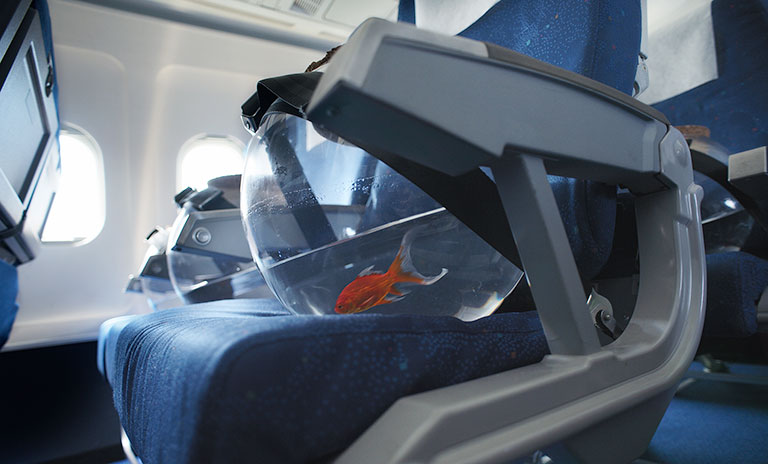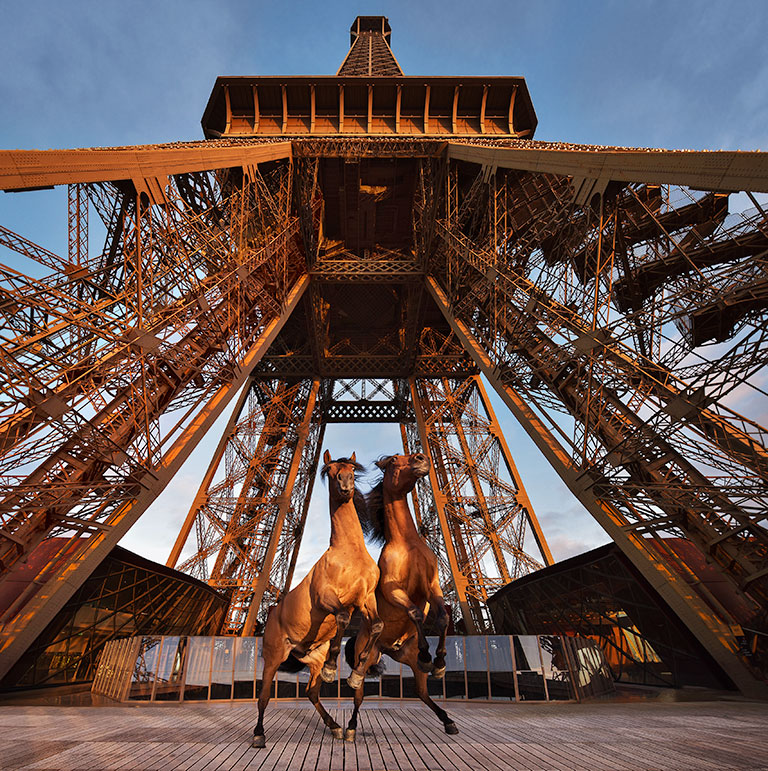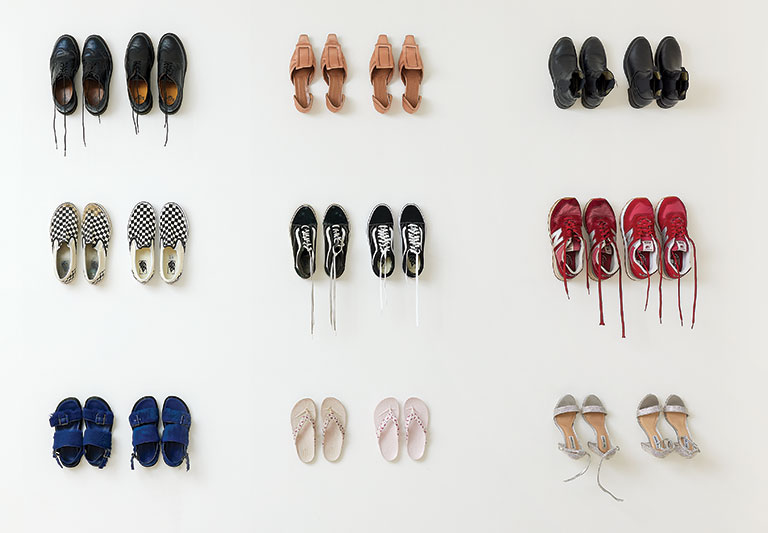If you want to walk a mile or even just around the block in Paola Pivi’s shoes, be prepared to take some bold steps. This conceptual contemporary artist isn’t interested in playing it safe. She isn’t concerned about the critics or naysayers. As a true citizen of the world, Pivi is unbound by conventions and preconceived ideas about the nature of art—or life, for that matter.
Throughout her decades-long career, Pivi has created some consequential—in terms of scale, logistics, and vision—works of art. She has turned a 10-wheeler truck on its side (Camion, 1997); taken 84 goldfish to new heights by way of commercial airliners (I Wish I Am Fish, 2009); crafted a celebration of colorfully plumaged polar bears (You started it … I finish it, 2013); and plastered gallery walls with printouts of coronavirus-inspired memes (25,000 Covid Jokes {It’s Not a Joke}, 2021).

Paola Pivi, I Wish I Am Fish, 2009, Photograph by Hugo Glendinning, Courtesy Auckland Art Gallery Toi o Tamaki and The Chartwell Trust, Auckland
Beginning April 22, Earth Day, The Andy Warhol Museum’s second floor will be transformed into Pivi’s playhouse of sorts as the museum debuts several newly commissioned pieces by the artist and reintroduces many of her classics. Appropriately titled Paola Pivi: I Want It All, the show will feature a 400-page publication, complete with new scholarship that includes an essay by The Warhol’s chief curator, José Diaz, and it will run through August 15.
“Her work comes to life almost as a science experiment,” Diaz says. “There’s an element of surrealism, a sense of mystery and humor. Like Andy Warhol, she is multidisciplinary, moving between photography and video, sculpture and performance. She breaks down boundaries.”
First Steps
It seems Pivi was born with a passport in her hand. A native of Milan, Italy, she has lived in Alicudi, Sicily; New Delhi, India; and now Anchorage, Alaska. Pivi found her way to Alaska in 2005 by way of the Iditarod dog-sled race. Feeling restless and a bit bored with her life and her art at the time, she wrangled a press pass from Artforum magazine and traveled to the 49th state to cover the annual mushing competition. The idea might have started as a lark, but the reality of it was no joke.
“I knew I didn’t know anything about surviving in Alaska, and so I asked for help well in advance of the event and took things in very small steps,” Pivi recalls.
After hiring a guide/pilot, she faithfully followed the race—all 1,000 miles of it—and then followed her heart and moved to Alaska. Although she’s been living there for more than 15 years, she still considers herself a visitor.
“Everything is so breathtakingly beautiful here,” Pivi says. “But humans are guests in Alaska, whereas in a city we feel like we own every inch of concrete. I see other people who are completely relaxed and at ease in a city. Of course, I’m totally attracted by the fun of a city, I just cannot stay long.
“I always felt like I could pick the places that most resonated with me and would give me a deeper, more interesting life,” she adds. “That’s why I hop from place to place.”
Her companions on this continuing journey are her husband, Tibetan musician and writer Karma Culture Brothers, and their 12-year-old son.
As a young woman just starting her career in Milan—a swirling metropolis of industry and fashion—Pivi initially set her sights on an engineering degree, and from 1990 to 1995 studied at Politecnico di Milano. She soon changed directions and enrolled in the city’s Brera Academy of Fine Arts. Although she never officially completed the program, she did find her footing.
By 1999, her installation of a Fiat G.91 fighter jet turned upside down was the talk of the Venice Biennale and the winner of its Golden Lion Award. But it wasn’t until she happened to cross paths with two ostriches that her work began to take on a unique focus. And no one was more surprised than Pivi herself. “I never interacted with animals until late in my 20s,” she says, “and since then it has been incessant; the animals keep coming.”
Animal Tracks
At the time, Pivi—along with the ostriches, a bunch of donkeys, and fewer than 100 people—were all living together on the tiny island of Alicudi, part of a volcanic archipelago north of Sicily. Inspired by her chance encounter with the fowls, she decided to do something different, something daring. She placed them in a boat, set them adrift (not far from shore) on the Mediterranean Sea, and took pictures.

Paola Pivi, Untitled (Donkey), 2003, Photograph by Hugo Glendinning, Courtesy MASSIMODECARLO
Photos of a donkey on that same boat floating on the same sea soon followed and made their debut at the 50th Venice Biennale. A huge print of the ass also graced the side of Brown University’s Sciences Library for several months just prior to the 2004 presidential election. A foot note: Thanks to Brown University’s public art loan program, works from an array of artists, including Urs Fischer and Isamu Noguchi, have adorned the campus. But not every installation enjoys the celebrity status afforded Pivi’s donkey. Students were so enamored with the equine they created a Facebook page in its honor.
“Paola is unpredictable,” Diaz says. “You’ll never know what she’ll come up with next, and that’s part of the joy. She engages with the natural world and infuses it with our world, the manufactured world.”
The results are at once confusing and captivating, strange yet somehow familiar. Imagine two zebras standing on a snow-covered mountain, a crocodile emerging from the waters of the Everglades topped with whipped cream, and a leopard negotiating its way through 3,000 cups of faux cappuccino. Pivi not only imagined these scenes but also brought them to life. Real life, not a Photoshopped facsimile. (And rest assured, no animals are ever harmed in the making of her art.)
Her grand finale of photo-performance involving animals was 2015’s Yee-haw, staged within the Eiffel Tower. Virginie Couperie-Eiffel, the great-granddaughter of the monument’s creator, was looking for someone to “activate the space” in a new and unexpected way to promote that year’s Longines Paris Eiffel Jumping, a horse-riding event that takes place under the shadow of the tower.
Enter Pivi.
Flanked by her crew—including photographer Hugo Glendinning and videographers —and four professionally trained thoroughbred horses, two white and two brown, she directed a series of pre-dawn photo shoots.

Paola Pivi, Yee-haw, 2015, Courtesy of the artist and Perrotin, Photo by Hugo Glendinning
“Paola is unpredictable. You’ll never know what she’ll come up with next, and that’s part of the joy.She engages with the natural world and infuses it with our world, the manufactured world.”
-José Diaz, Chief Curator of The Andy Warhol Museum
“Sometimes I get a very fixed image,” Pivi said in a Wallpaper.com article, “and sometimes it is not so fixed. In this case it was just the idea to put the horses and the tower together. And I was open to seeing what would happen. But in other cases the idea is much more formed and I just made it happen. Like when I placed the ostriches on the boat.”
In that same Wallpaper story, Pivi talks about how incredibly well-trained the horses were, seemingly undaunted by the elevator ride that took them to the first-level platform where they galloped and galivanted, posed and postured in front of a crowd of curious onlookers, Then, as Diaz recounted, “Something beautiful happened. As the sun began to rise and the sky began to change from dark to light, the horses and the Eiffel Tower became one—one creature. It was a magical moment.”
That series will be on display as part of Pivi’s exhibition at The Warhol.
Bearfeet
There’s magic to be found in Pivi’s polar bears, as well. She adorns the sculpted figures with neon red, green, purple, orange, and pink feathers and poses them in distinctly unbear-like positions: swinging on a trapeze, practicing yoga, engaging in conversation. The adult-size bears are perhaps Pivi’s most recognizable project, and they gave birth, so to speak, to a set of toddler bears dubbed We Are the Baby Gang.
About 30 members of the gang—including I just miss my mom, Are you the manager? and I bring art where I go—will be hanging out at The Warhol this spring.

Clockwise from top: Paola Pivi, Don’t make me wait; It is ok to have extra; Is it a date?, 2019, Courtesy of the artist and Perrotin, Photo by Guillaume Ziccarelli
The monikers associated with many of the mini-bears are the brain child of Pivi’s husband, Karma. “The titles are artworks in themselves,” she says. “They show how just a few words can unlock a door into the art and set a mood. When you read them it’s impossible not to laugh or smile.”
Incorporating others into the creative process is an essential component of Pivi’s practice. “What we do in contemporary art is a form of collaboration—a dialogue,” she says. “When I have a show there is a group of people who participate. It starts with the curator, and then everybody involved in the manufacturing, the presentation, promotion, installation, and funding. It is a huge group of people who want to have this dialogue.
“And then there is another group of people who want to receive it.”
But don’t expect Pivi to qualify or explain her work. She rejects attempts to label her art as political or environmental. If she has an agenda, she’s not talking.
From Diaz’s perspective, however, visitors won’t have to look very far to see the bigger picture. “Paola will not call herself an activist,” he says, “but to me her polar bears are reminders of the atrocities happening to our land, our water, to the world around us. And yet, at the same time, there’s hope, humor, and whimsy. The bears look like a field of flowers, a toy store, or a circus.
“Paola finds beauty in the most simple, mundane—ordinary—things.”
These Boots Were Made For …
They’re one of the most necessary of all accessories. Think about it. Whether they’re insanely expensive or bargain-basement, fashion-forward or orthopedic, at the end of the day, most people really can’t leave home without them.
Necessary, yes. But for many of us, shoes are so much more.
“At one point in my life I had a pair of Jimmy Choos. They were boots with stiletto heels,” Pivi says. “And when I was a young person roaming the world and finding my path, I used my shoes and clothes to the point of laceration.”
We all know the feeling: You bond with a pair of shoes and never want to let them go. So Pivi did what many of us would have done in that situation. She bought the exact same boots again. And that’s when it hit her.
“I thought, ‘Wow, this is strikingly cool,’” she recalls. “I didn’t make a big deal about it, but the idea lingered in my head. The comparison between the old and the new was so strong, especially because shoes keep the memory of our lives. They are our contact with the planet and our contact with movement—and so, therefore, with experience.”
If that doesn’t prompt you to rethink your relationship to footwear, consider this. “Shoes are like miniature sculptures,” Diaz adds. “We wear them to protect ourselves and adorn ourselves, like feathers or fur in the natural world.”
But bringing shoes to life by wearing them to death requires time. Fortunately, Pivi’s Warhol show has been four years in the making, and that allowed the artist and curator to develop a plan of action to transform her idea into something tangible.

Paola Pivi, Untitled (shoes) (detail), 2022, Courtesy of the artist, The Andy Warhol Museum, and Perrotin, Photo by Agostino Osio
To that end, 125 people—friends of Pivi and friends of the museum, scattered throughout the globe—agreed to wear specific pairs of shoes as often as possible for an entire year and then ship them to The Warhol. Diaz reports that he and his pair of baby-blue Hush Puppies have been practically inseparable the entire time, and visitors will be able to see the Puppies immortalized as part of the exhibition.
After the 125 pairs of shoes arrive at the museum, they’re disinfected and then united with their identical, albeit brand-new, counterparts. From there, each set of worn/unworn twins—250 in total, ranging from Manolo Blahniks to Crocs, Bottega Venetas to Converses—will be mounted to the second-floor gallery walls in a grid-like pattern. Think animal trophies or butterfly specimens.

Paola Pivi, Untitled (shoes) (detail), 2022, Courtesy of the artist, The Andy Warhol Museum, and Perrotin, Photo by Agostino Osio
“We’re taking the shoes out of context, retiring them as fashion and function, and turning them into an art installation,” Diaz says. “This is a commissioned piece, exclusive to The Warhol. We want to show the contrast between shoes that have lived a full life and those just out of the box.”
“Warhol liked having people around him and he liked presenting people to the world. I, too, am a voyeur to the lives of the people who wore these shoes, and I’m presenting something very intimate of these people and putting it onto the gallery walls.”
-Paola Pivi
The installation is also a fitting homage to Andy Warhol’s adman days. During his first decade in New York City, Warhol was a commercial artist, and a successful one at that; his long list of high-end retail clients included I. Miller & Sons. Throughout his tenure with the company, he produced some 300 illustrations of women’s shoes, many appearing as full-page advertisements in the Sunday edition of The New York Times.
“This shoe installation is connected—literally—to Warhol’s legacy,” Pivi says. “He made so many amazing drawings of shoes.”
But there’s another, deeper layer to explore. “I don’t want to call him a voyeur because there are so many negative connotations in this word,” she continues. “But Warhol liked having people around him and he liked presenting people to the world. I, too, am a voyeur to the lives of the people who wore these shoes, and I’m presenting something very intimate of these people and putting it onto the gallery walls.”
Pivi also feels a connection to The Warhol Museum and all it represents. “It is an alive museum, vibrant and exciting,” she says. “And my show is nested inside, surrounded by its history and energy. We artists need to be protected, shielded so that we can dare.
“And you want us to dare, right? You want us to give you our best. You want us to try and maybe even fail, but to try rather than to limit ourselves.”
Paola Pivi: I Want It All is generously supported by The Fine Foundation.
Receive more stories in your email
Sign upTags:
Art
